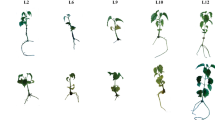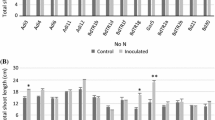Abstract
A collection of bacterial strains obtained from a wide-range origin was screened for ability to promote growth in two types of Prunus rootstocks in a commercial nursery. Only few strains promoted growth significantly and consistently, and a strong specificity for the rootstock cultivar was observed. Irrigation of plants with Pseudomonas fluorescens EPS282 and Pantoea agglomerans EPS427 significantly increased plant height and root weight of the plum Marianna 2624 and the peach–almond hybrid GF-677, respectively. Plant height showed a higher rate of growth in early stages of development (2.6–3.5 times the non-treated controls), but the effect decreased with plant age. However, in aged plants growth promotion was more significant on root weight (1.9 times the non-treated controls) than on plant height. The efficacy of growth promotion and the persistence of strains in the root environment were dependent on the bacterial inoculum concentration applied. Increases in root development were maximum at inoculum concentrations of up to 8 log10 CFU ml−1 (ca 10 log10 CFU L−1 of potting mix). Population levels at the optimum inoculum concentration were around 7 log10 CFU g f.w.−1 root material at early stages of development and decreased to 4 log10 CFU g f.w.−1 after several months of development. The best plant growth-promoting strains were very diverse in secondary metabolite production and antagonistic ability against several plant pathogens.
Similar content being viewed by others
References
Alemany J 2001 Characterization of metabolites produced by Pseudomonas fluorescens effective in the biological control of fungal phytopathogens. PhD Thesis. University of Girona.
Anderson A J and Guerra D 1985 Responses of bean to root colonization with Pseudomonas putida in a hydroponic system. Phytopathology 75, 992–995.
Åström B 1991 Role of bacterial cyanide production in differential reactions of plant cultivars to deleterious rhizosphere pseudomonads. Plant Soil 133, 93–100.
Bahme J B, Schroth M N, Van Gundy S D, Weinhold A R and Tolentino D M 1988 Effect of inocula delivery systems on rhizobacterial colonization of underground organs of potato. Phytopathology 78, 534–542.
Barazani O and Friedman J 1999 Is IAA the major root growth factor secreted from plant-growth-mediating bacteria? J. Chem. Ecol. 25, 2397–2406.
Becker J O and Cook R J 1988 Role of siderophores in suppression of Pythium species and production of increased-growth response of wheat by fluorescent pseudomonads. Phytopathology 78, 778–782.
Benizri E, Baudoin E and Guckert A 2001 Root colonization by inoculated plant growth-promoting rhizobacteria. Biocontrol Sci. Technol. 11, 557–574.
Boruah H P and Dileep Kumar B S 2002 Biological activity of secondary metabolites produced by a strain of Pseudomonas fluorescens. Folia Microbiol. 47, 359–363.
Brito Alvarez M A, Gagné S and Antoun H 1995 Effect of compost on rhizosphere microflora of the tomato and on the incidence of plant growth-promoting rhizobacteria. Appl. Environ. Microbiol. 61, 194–199.
Burr T J, Schroth M N and Suslow T V 1978. Increased potato yields by treatments of seed pieces with specific strains of Pseudomonas fluorescens and P. putida. Phytopathology 68, 1377–1383.
Caesar A J and Burr T J 1987 Growth promotion of apple seedlings and rootstocks by specific strains of bacteria. Phytopathology 77, 1583–1588.
Chabot R, Antoun H, Kloepper J W and Beauchamp C J 1996 Root colonization of maize and lettuce by bioluminiscent Rhizobium leguminosarum biovar phaseoli. Appl. Environ. Microbiol. 62, 2767–2772.
Dashti N, Zhang F, Hynes R and Smith D L 1997 Application of plant growth-promoting rhizobacteria to soybean (Glycine max (L.) Merr.) increases protein and dry matter yield under shortseason conditions. Plant Soil 188, 33–41.
Dashti N, Zhang F, Hynes R and Smith D L 1998 Plant growth promoting rhizobacteria accelerate nodulation and increase nitrogen fixation activity by field grown soybean [Glycine max (L.) Merr.] under short season conditions. Plant Soil 200, 205–213.
Dileep Kumar B S and Dube H C 1992 Seed bacterization with a fluorescent Pseudomonas for enhanced plant growth, yield and disease control. Soil Biol. Biochem. 24, 539–542
Dileep Kumar B S, Berggren I and Mårtenson A M 2001 Potential for improving pea production by co-inoculation with fluorescent Pseudomonas and Rhizobium. Plant Soil 229, 25–34.
Dye D W 1969 A taxonomic study of the genus Erwinia. III The “herbicola” group. N. Z. J. Sci. 12, 833–839.
Ellis R J, Timms-Wilson T M and Bailey M J 2000. Identification of conserved traits in fluorescent pseudomonads with antifungal activity. Environ. Microbiol. 2, 274–284.
Ewing W H and Fife M A 1972 Enterobacter agglomerans (Beijerinck) comb. nov. (the herbicola-lathyri bacteria). Int. J. Syst. Bacteriol. 22, 4–11.
Frändberg and Shnürer D 1998 Antifungal activity of chitinolytic bacteria isolated from airtight stored cereal grain. Can. J. Microbiol. 44, 121–127.
Gagné S, Dehbi L, Le Quéré D, Cayer F, Morin J L, Lemay L, Fournier N 1993 Increase of greenhouse tomato fruit yields by plant growth-promoting rhizobacteria (PGPR) inoculated into the peat-based growing media. Soil Biol. Biochem. 25, 269–272.
Gardner J M, Chandler J L and Feldman A W 1984 Growth promotion and inhibition by antibiotic-producing fluorescent pseudomonads on citrus roots. Plant Soil 77, 103–113.
Gavini F, Mergaert J, Beji A, Mielcarek C, Izard D, Kersters K, de Ley J 1989 Transfer of Enterobacter agglomerans (Beijerink 1888) Ewing and Fife 1972 to Pantoea gen. nov. as Pantoea agglomerans comb. nov. and description of Pantoea dispersa sp.nov. Int. J. Syst. Bacteriol. 39, 337–345.
Germida J J and Walley F L 1996 Plant growth-promoting rhizobacteria alter rooting patterns and arbuscular mycorrhizal fungi colonization of field-grown spring wheat. Biol. Fertil. Soils. 23, 113–129.
Gutierrez-Mañero F J, Acero N, Lucas J A and Probanza A 1996 The influence of native rhizobacteria on European alder (Alnus glutinosa (L.) Gaertn.) growth. Plant Soil 182, 67–74.
Handelsman J and Staab E V 1996 Biocontrol of soilborne plant pathogens. Plant Cell 8, 1855–1869
Howie W J and Echandi E 1983 Rhizobacteria: Influence of cultivar and soil type on plant growth and yield of potato. Soil Biol. Biochem. 15, 127–132.
Johnson K B 1994 Dose-response relationships and inundative biological control. Phytopathology 84, 780–784.
Keel C, Schinder U, Maurhofer M, Voisard M, Laville J, Burger U, Wirthner P, Haas D and Défago G 1992 Suppresion of root diseases by Pseudomonas fluorescens CHAO: importance of the bacterial secondary metabolite 2,4-diacetylphloroglucinol. Mol. Plant-Microbe Interact. 5, 4–13.
King E O, Ward M K and Rainey D E 1954 Two simple media for the demonstration of the pyocyanin and fluoroscein. J. Lab. Clin. Med. 44, 301–307
Kloepper J W 1992 Plant growth-promoting rhizobacteria as biological control agents. In F. Blaine Metting, Jr. (ed.) pp. 255–274. Soil Microbial Ecology. Marcel Dekker, New York.
Kloepper J W 1996 Host specificity in microbe-microbe interactions. Bioscience 46, 406–409.
Kloepper J W, Schroth M N and Miller T D 1980 Effects of rhizosphere colonization by plant growth-promoting rhizobacteria on potato plant development and yield. Phytopathology 70, 1078–1082.
Kloepper J W, Hume D J, Scher F M, Singleton C, Tipping B, Laliberté M, Frauley K, Kutchaw T, Simonson C, Lifshitz R, Zaleska I and Lee L 1988 Plant growth-promoting rhizobacteria on canola (rapeseed). Plant Dis. 72, 42–46.
Landa B B, Mavrodi O V, Raaijmakers J M, McSpadden Gardener B B, Thomashow L S and Weller D M 2002 Differential ability of genotypes of 2,4-diacetylphloroglucinol-producing Pseudomonas fluorescens strains to colonize the roots of pea plants. Appl. Environ. Microbiol. 68, 3226–3237.
Latour X, Corberand T, Laguerre G, Allard F and Lemanceau P 1996 The composition of fluorescent pseudomonad population associated with roots is influenced by plant and soil type. Appl. Environ. Microbiol. 62, 2449–2456.
Leeman M, van Pelt J A, Hendrickx M J, Scheffer R J, Bakker P A H M and Schippers B 1995 Biocontrol of Fusarium wilt of radish in commercial greenhouse trials by seed treatment with Pseudomonas fluorescens WCS374. Phytopathology 85, 1301– 1305.
Lindow S E, Arny D C and Upper C D 1983 Biological control of frost injury: An isolate of Erwinia herbicola antagonistic to ice nucleation active bacteria. Phytopathology 73, 1097–1102.
Liu L, Kloepper J W and Tuzun S 1995 Induction of systemic resistance in cucumber against bacterial angular leaf spot by plant-promoting rhizobacteria. Phytopathology 85, 843–847.
Maniatis T, Fritsch E F and Sambrook J 1982 Molecular Cloning: A laboratory manual. Cold Spring Harbor Laboratory, Cold Spring Harbor, NY.
Maurhofer M, Hase C, Meuwly P, Métraux J-P and Défago G 1994 Induction of systemic resistance of tobaccco to tobacco necrosis virus by the root-colonizing Pseudomonas fluorescens strain CHAO: Influence of the gacA gene and of pyoverdine production. Phytopathology 84, 139–146.
Mazzola M, Cook R J, Thomashow L S, Weller D M and Pierson L S III 1992 Contribution of phenazine antibiotic biosynthesis to the ecological competence of fluorescents pseudomonads in soil habitats. Appl. Environ. Microbiol. 58, 2616–2624.
Miller T D and Schroth M N 1972 Monitoring the epiphytic population of Erwinia amylovora on pear with selective media. Phytopathology 62, 1175–1182.
Mirza M S, Ahmad W, Latif F, Haurat J, Bally R, Normand P and Malik K A 2001 Isolation, partial characterization, and the effect of plant growth-promoting bacteria (PGPB) on micro-propagated sugarcane in vitro. Plant Soil 237, 47–54.
Montesinos E and Bonaterra A 1996 Dose-response models in biological control of plant pathogens: An empirical verification. Phytopathology 86, 464–472.
Montesinos E, Bonaterra A, Ophir Y and Beer S V 1996 Antagonism of selected bacterial strains to Stemphylium vesicarium and biological control of brown spot of pear under controlled environment conditions. Phytopathology 86, 856–863.
O'sullivan D J and O'Gara F 1992 Traits of fluorescent Pseudomonas spp. involved in suppression of plant root pathogens. Microbiol. Rev. 56, 662–676.
Palleroni N J 1984 Genus I Pseudomonas. In Bergey's Manual of Determinative Bacteriology, 8 ed. Eds. N R Krieg and J G Holt pp. 141–199. Williams & Wilkins Co., Baltimore, MD.
Rainey P B, Bailey M J and Thompson I P 1994 Phenotypic and genotypic diversity of fluorescent pseudomonads isolated from field grown sugarbeet. Microbiology 140, 2315–2331.
Raupach G S and Kloepper J W 1998 Mixtures of plant growth promoting rhizobacteria enhance biological control of multiple cucumber pathogens. Phytopathology 88, 1158–1164.
Rodríguez-Barrueco C, Cervantes E, Subbarao N S and Rodríguez-Caceres E 1991 Growth promoting effect of Azospirillum brasilense on Casuarina cunninghamiana Miq. seedlings. Plant Soil. 135, 121–124.
Schippers B A, Bakker W, Bakker P and Van Peer R 1991 Beneficial and deleterious effects of HCN-producing pseudomonads on rhizosphere interactions. Plant Soil 129, 75–83.
Schwyn B and Neilands J B 1987 Universal chemical assay for the detection and the determination of siderophores. Anal. Biochem. 160, 47–56.
Sneath P H A 1966. Identification methods applied to Chromobacterium. In Identification Methods for Microbiologist, Part A. Eds B M Gibb and F A Skinner. pp. 15–20. Academic Press, London.
Utkhede R S and Smith E M 1992 Promotion of apple tree growth and fruit production by the EBW-4 strain of Bacillus subtilis in apple replant disease soil. Can. J. Microbiol. 38, 1270–1273.
Vanderplank J E 1975 Principles of Plant Infection. Academic Press, New York.
van Overbeek L S and Van Elsas J D 1995 Root exudate-induced promoter activity in Pseudomonas fluorescens mutants in the wheat rhizosphere. Appl. Environ. Microbiol. 61, 890–898.
Weller D M, Raaijmakers J M, McSpadden Gardener B B and Thomashow L S 2002 Microbial populations responsible for specific soil suppressiveness to plant pathogens. Annu. Rev. Phytopathol. 40, 309–348.
Wodzinski R S and Paulin J P 1994 Frequency and diversity of antibiotic production by putative Erwinia herbicola strains. Appl. Bacteriol. 76, 603–607.
Author information
Authors and Affiliations
Corresponding author
Rights and permissions
About this article
Cite this article
Bonaterra, A., Ruz, L., Badosa, E. et al. Growth promotion of Prunus rootstocks by root treatment with specific bacterial strains. Plant and Soil 255, 555–569 (2003). https://doi.org/10.1023/A:1026033115984
Issue Date:
DOI: https://doi.org/10.1023/A:1026033115984




